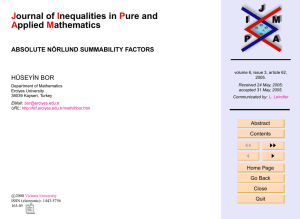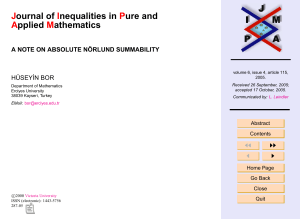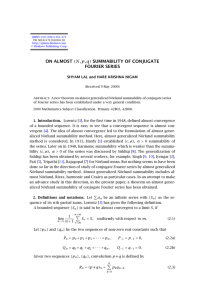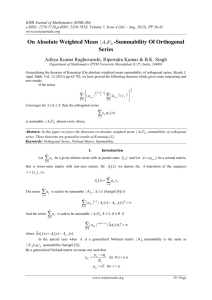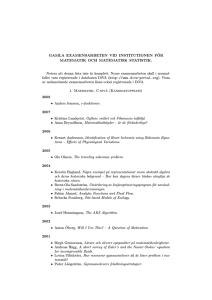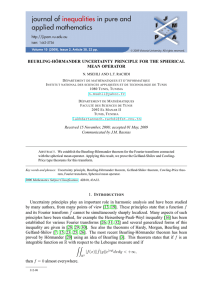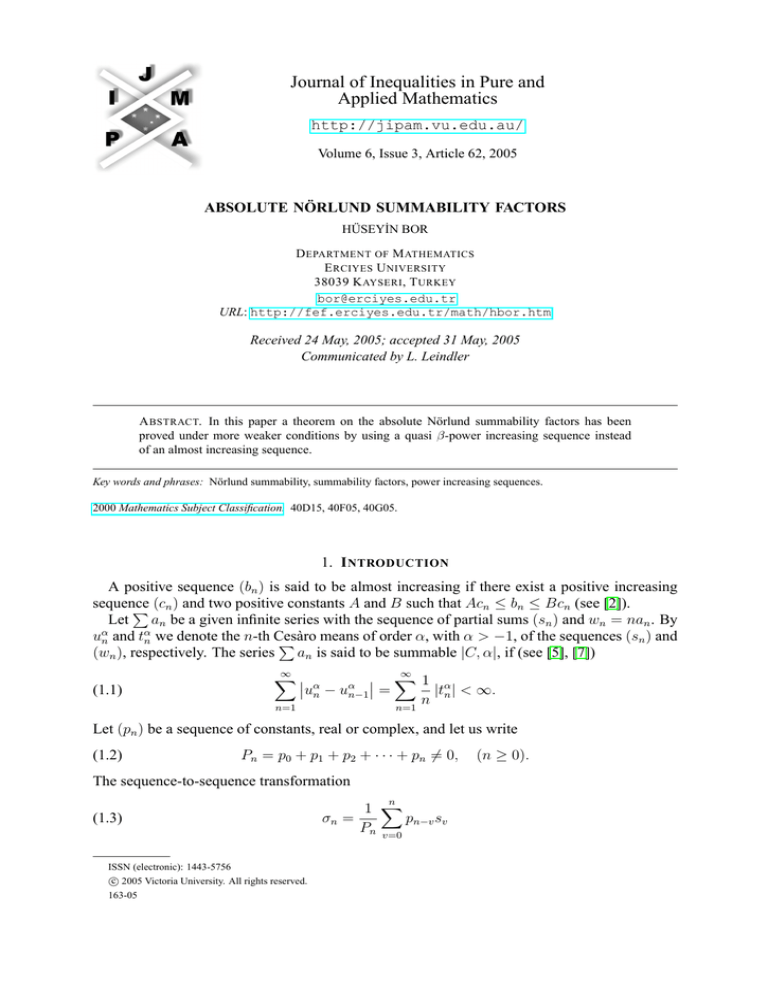
Journal of Inequalities in Pure and
Applied Mathematics
http://jipam.vu.edu.au/
Volume 6, Issue 3, Article 62, 2005
ABSOLUTE NÖRLUND SUMMABILITY FACTORS
HÜSEYİN BOR
D EPARTMENT OF M ATHEMATICS
E RCIYES U NIVERSITY
38039 K AYSERI , T URKEY
bor@erciyes.edu.tr
URL: http://fef.erciyes.edu.tr/math/hbor.htm
Received 24 May, 2005; accepted 31 May, 2005
Communicated by L. Leindler
A BSTRACT. In this paper a theorem on the absolute Nörlund summability factors has been
proved under more weaker conditions by using a quasi β-power increasing sequence instead
of an almost increasing sequence.
Key words and phrases: Nörlund summability, summability factors, power increasing sequences.
2000 Mathematics Subject Classification. 40D15, 40F05, 40G05.
1. I NTRODUCTION
A positive sequence (bn ) is said to be almost increasing if there exist a positive increasing
sequence
P (cn ) and two positive constants A and B such that Acn ≤ bn ≤ Bcn (see [2]).
Let an be a given infinite series with the sequence of partial sums (sn ) and wn = nan . By
uαn and tαn we denote the n-th Cesàro
means of order α, with α > −1, of the sequences (sn ) and
P
(wn ), respectively. The series an is said to be summable |C, α|, if (see [5], [7])
(1.1)
∞
∞
X
α
X
1 α
un − uαn−1 =
|t | < ∞.
n n
n=1
n=1
Let (pn ) be a sequence of constants, real or complex, and let us write
(1.2)
Pn = p0 + p1 + p2 + · · · + pn 6= 0,
The sequence-to-sequence transformation
(1.3)
ISSN (electronic): 1443-5756
c 2005 Victoria University. All rights reserved.
163-05
n
1 X
σn =
pn−v sv
Pn v=0
(n ≥ 0).
2
H ÜSEYIN B OR
defines the sequence (σn ) of theP
Nörlund mean of the sequence (sn ), generated by the sequence
of coefficients (pn ). The series an is said to be summable |N, pn |, if (see [9])
∞
X
(1.4)
|σn − σn−1 | < ∞.
n=1
In the special case when
pn =
(1.5)
Γ(n + α)
,
Γ(α)Γ(n + 1)
α≥0
the Nörlund mean reduces to the (C, α) mean and |N, pn | summability becomes |C, α| summability. For pn = 1 and Pn = n, we get the (C, 1) mean and then |N, pn | summability becomes
|C, 1| summability. For any sequence (λn ), we write ∆λn = λn −λn+1 and ∆2 λn = ∆(∆λn ) =
∆λn − ∆λn+1 .
In [6] Kishore has proved the following theorem concerning |C, 1| and |N, pn | summability
methods.
P
Theorem 1.1. Let p0 >
0,
p
≥
0
and
(p
)
be
a
non-increasing
sequence.
If
an is summable
n
n
P
|C, 1|, then the series an Pn (n + 1)−1 is summable |N, pn |.
Ahmad [1] proved the following theorem for absolute Nörlund summability factors.
Theorem 1.2. Let (pn ) be as in Theorem 1.1. If
n
X
1
(1.6)
v=1
v
|tv | = O(Xn ) as n → ∞,
where (Xn ) is a positive non-decreasing sequence and (λn ) is a sequence such that
(1.7)
Xn λn = O(1),
(1.8)
n∆Xn = O(Xn ),
X
(1.9)
then the series
P
nXn ∆2 λn < ∞,
an Pn λn (n + 1)−1 is summable |N, pn |.
Later on Bor [3] proved Theorem 1.2 under weaker conditions in the following form.
Theorem 1.3. Let (pn ) be as in Theorem 1.1 and let (Xn ) be a positive non-decreasing sequence. If the conditions (1.6) and (1.7) of Theorem 1.2 are satisfied and the sequences (λn )
and (βn ) are such that
(1.10)
|∆λn | ≤ βn ,
(1.11)
βn → 0,
X
(1.12)
then the series
P
nXn |∆βn | < ∞,
an Pn λn (n + 1)−1 is summable |N, pn |.
Also Bor [4] has proved Theorem 1.3 under the weaker conditions in the following form.
J. Inequal. Pure and Appl. Math., 6(3) Art. 62, 2005
http://jipam.vu.edu.au/
A BSOLUTE N ÖRLUND S UMMABILITY FACTORS
3
Theorem 1.4. Let (pn ) be as in Theorem 1.1 and let (Xn ) be an almost increasing sequence. If
the conditions
P (1.6), (1.7), (1.10) and (1.12) of Theorem 1.2 and Theorem 1.3 are satisfied, then
the series an Pn λn (n + 1)−1 is summable |N, pn |.
2. M AIN R ESULT
The aim of this paper is to prove Theorem 1.4 under more weaker conditions. For this we
need the concept of a quasi β-power increasing sequence. A positive sequence (γn ) is said to
be a quasi β-power increasing sequence if there exists a constant K = K(β, γ) ≥ 1 such that
Knβ γn ≥ mβ γm
(2.1)
holds for all n ≥ m ≥ 1. It should be noted that every almost increasing sequence is a quasi
β-power increasing sequence for any nonnegative β, but the converse need not be true as can be
seen by taking an example, say γn = n−β for β > 0. So we are weakening the hypotheses of
the theorem replacing an almost increasing sequence by a quasi β-power increasing sequence.
Now we shall prove the following theorem.
Theorem 2.1. Let (pn ) be as in Theorem 1.1 and let (Xn ) be a quasi β-power increasing
sequence. If the conditions
P (1.6), (1.7), (1.10) and (1.12) of Theorem 1.2 and Theorem 1.3 are
satisfied, then the series an Pn λn (n + 1)−1 is summable |N, pn |.
We need the following lemma for the proof of our theorem.
Lemma 2.2 ([8]). Under the conditions on (Xn ), (λn ) and (βn ), as taken in the statement of
the theorem, the following conditions hold, when (1.12) is satisfied:
(2.2)
as n → ∞,
nβn Xn = O(1)
∞
X
(2.3)
βn Xn < ∞.
n=1
Proof of Theorem 2.1. In order to prove the theorem,P
we need consider only the special case in
which (N, pn ) is (C, 1), that is, we shall prove that
an λn is summable |C, 1|. Our theorem
will then follow by means of Theorem 1.1. Let Tn be the n-th (C, 1) mean of the sequence
(nan λn ), that is,
n
Tn =
(2.4)
1 X
vav λv .
n + 1 v=1
Using Abel’s transformation, we have
n
Tn =
1 X
vav λv
n + 1 v=1
n−1
1 X
=
∆λv (v + 1)tv + λn tn
n + 1 v=1
= Tn,1 + Tn,2 ,
say.
To complete the proof of the theorem, it is sufficient to show that
(2.5)
∞
X
1
|Tn,r | < ∞
n
n=1
J. Inequal. Pure and Appl. Math., 6(3) Art. 62, 2005
for r = 1, 2, by (1.1).
http://jipam.vu.edu.au/
4
H ÜSEYIN B OR
Now, we have
m+1
X
n=2
( n−1
)
m+1
Xv+1
X
1
1
|Tn,1 | ≤
v |∆λv | |tv |
n
n(n
+
1)
v
n=2
v=1
( n−1
)
m+1
X 1 X
vβv |tv |
= O(1)
n2 v=1
n=2
= O(1)
= O(1)
m
X
v=1
m
X
vβv |tv |
vβv
v=1
= O(1)
m−1
X
= O(1)
1
n2
n=v+1
|tv |
v
∆(vβv )
v=1
m−1
X
m+1
X
v
X
|tr |
r=1
r
+ O(1)mβm
m
X
|tv |
v=1
v
|∆(vβv )| Xv + O(1)mβm Xm
v=1
= O(1)
m−1
X
|(v + 1)∆βv − βv | Xv + O(1)mβm Xm
v=1
= O(1)
m−1
X
v |∆βv | Xv + O(1)
v=1
m−1
X
|βv | Xv + O(1)mβm Xm
v=1
as m → ∞,
= O(1)
by (1.6), (1.10), (1.12), (2.2) and (2.3).
Again
m
m
X
X
1
|tn |
|Tn,2 | =
|λn |
n
n
n=1
n=1
=
m−1
X
∆ |λn |
n=1
= O(1)
n
X
|tv |
v=1
m−1
X
v
+ |λm |
m
X
|tn |
n=1
n
|∆λn | Xn + O(1) |λm | Xm
n=1
= O(1)
m−1
X
βn Xn + O(1) |λm | Xm = O(1)
as m → ∞,
n=1
by (1.6), (1.7), (1.10) and (2.3). This completes the proof of the theorem.
R EFERENCES
[1] Z.U. AHMAD, Absolute Nörlund summability factors of power series and Fourier series, Ann.
Polon. Math., 27 (1972), 9–20.
[2] S. ALJANČIĆ
(1977), 5–22.
AND
D. ARANDELOVIĆ, O-regularly varying functions, Publ. Inst. Math., 22
J. Inequal. Pure and Appl. Math., 6(3) Art. 62, 2005
http://jipam.vu.edu.au/
A BSOLUTE N ÖRLUND S UMMABILITY FACTORS
5
[3] H. BOR, Absolute Nörlund summability factors of power series and Fourier series, Ann. Polon.
Math., 56 (1991), 11–17.
[4] H. BOR, On the Absolute Nörlund summability factors, Math. Commun., 5 (2000), 143–147.
[5] M. FETEKE, Zur Theorie der divergenten Reihen, Math. es Termes Ertesitö (Budapest), 29 (1911),
719–726.
[6] N. KISHORE, On the absolute Nörlund summability factors, Riv. Math. Univ. Parma, 6 (1965),
129–134.
[7] E. KOGBENTLIANTZ, Sur lés series absolument sommables par la méthode des moyennes arithmétiques, Bull. Sci. Math., 49 (1925), 234–256.
[8] L. LEINDLER, A new application of quasi power increasing sequences, Publ. Math. Debrecen, 58
(2001), 791–796.
[9] F.M. MEARS, Some multiplication theorems for the Nörlund mean, Bull. Amer. Math. Soc., 41
(1935), 875–880.
J. Inequal. Pure and Appl. Math., 6(3) Art. 62, 2005
http://jipam.vu.edu.au/

